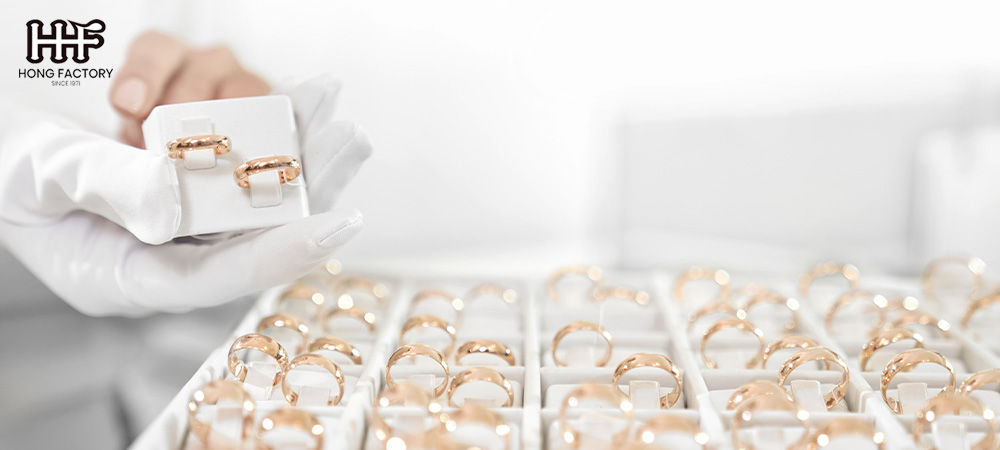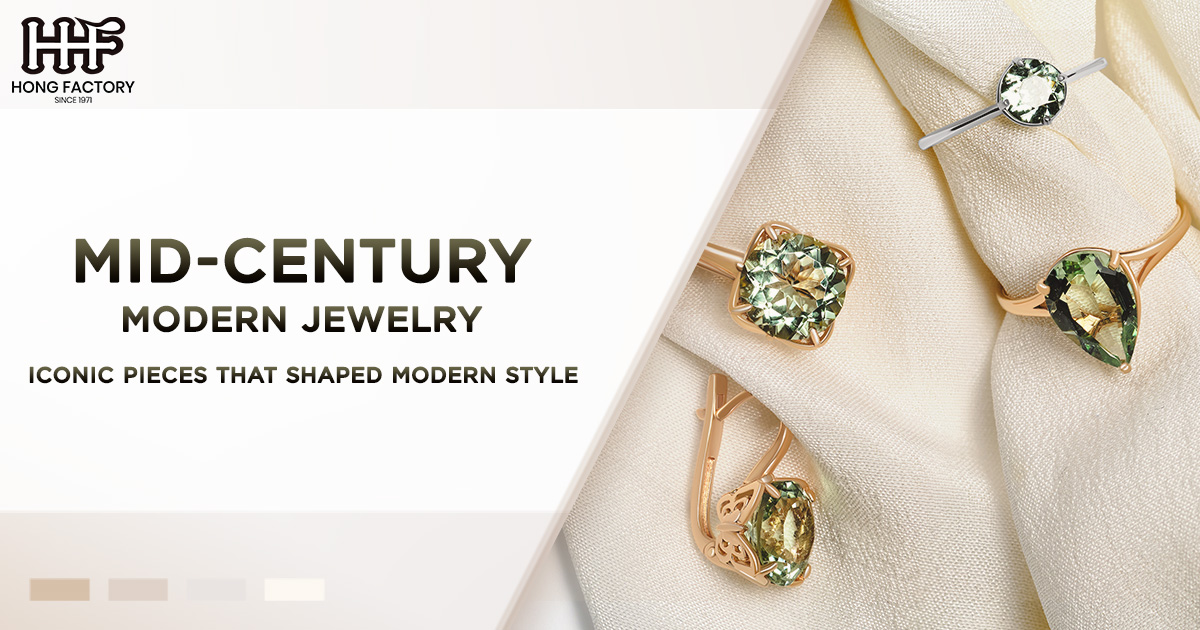The mid-20th century was a period of profound transformation in the world of art, architecture, fashion, and design. One of the most remarkable shifts during this era was the move towards modernism, a style that embraced simplicity, functionality, and the rejection of the ornate excesses of previous periods. Mid-century modern jewelry perfectly encapsulates this transition. With its focus on geometric designs, minimalism, and bold statement pieces, this style has left an indelible mark on contemporary fashion and design.
The Shift Towards Modern Design in the Mid-20th Century
Mid-century modernism emerged in the aftermath of World War II, a time when society was eager for change, progress, and innovation. This cultural shift was reflected in every facet of design, from architecture to furniture, and, of course, jewelry. The opulent and intricate designs of the past, which often featured elaborate detailing, heavy use of precious stones, and complex craftsmanship, began to give way to more modern, streamlined aesthetics.
One of the most significant influences on mid-century modern jewelry Marcasite jewelry was the Bauhaus movement. Founded in Germany in the early 20th century, Bauhaus emphasized the integration of art, craft, and technology, with a focus on simplicity, functionality, and the use of modern materials. Bauhaus principles helped shape the clean lines, geometric forms, and minimalist approach that became hallmarks of mid-century modern jewelry design.
During this period, designers began to move away from the traditional use of only gold and diamonds, experimenting with a wider range of materials. Silver, copper, brass, and non-precious metals became popular, as did the use of new technologies to create innovative designs. Designers sought to create pieces that were not just beautiful but also functional, wearable, and reflective of the modern spirit of the times.
Geometric Designs – A New Artistic Language
Geometric forms became a defining feature of mid-century modern jewelry. Circles, squares, triangles, and other simple shapes were used to create elegant, abstract designs that felt fresh and contemporary. These forms were often combined in unexpected ways, creating dynamic compositions that pushed the boundaries of traditional jewelry design.
One of the most iconic examples of geometric design in mid-century modern jewelry is the work of Danish designer Georg Jensen. Known for his sleek, minimalist pieces, Jensen often used organic, flowing shapes inspired by nature, combined with simple geometric forms. His designs, which were often crafted in silver, were a perfect blend of form and function, embodying the modernist ethos of the time.
Another key figure in the geometric design movement was American jewelry designer Margaret De Patta. A pioneer of modernist jewelry in the United States, De Patta was deeply influenced by Bauhaus principles and the Constructivist art movement. Her work explored the interplay between light, space, and form, often using transparent gemstones and clean, geometric lines to create pieces that were both sculptural and wearable. De Patta’s designs were revolutionary in their rejection of traditional ornamentation, instead focusing on the inherent beauty of simple forms and materials.
Geometric designs in mid-century modern jewelry were not just about aesthetics; they were also a reflection of a broader cultural shift towards abstraction and the dissolution of traditional boundaries in art and design. These pieces were seen as wearable art, blurring the line between fine art and functional object.
Minimalism – Less Is More
Minimalism was another key characteristic of mid-century modern jewelry. Designers of this era embraced the “less is more” philosophy, choosing to strip away unnecessary embellishments and focus on clean lines, simplicity, and purity of form. This minimalist approach was a reaction against the more ornate and decorative styles that had dominated jewelry design in previous decades, such as Art Deco and Victorian jewelry.
Minimalist mid-century jewelry often featured smooth, unadorned surfaces, with an emphasis on the intrinsic beauty of the materials themselves. Gold and silver were polished to a high shine, creating a sleek, modern look that was both elegant and understated. In many cases, gemstones were used sparingly, if at all, allowing the focus to remain on the form of the piece rather than its adornment.
One of the most famous proponents of minimalism in mid-century modern jewelry was Finnish designer Tapio Wirkkala. Known for his work in both jewelry and glass, Wirkkala’s designs were characterized by their simplicity and clarity of form. He often used organic shapes and natural materials, such as wood, combined with precious metals to create pieces that were both modern and timeless.
Minimalist jewelry from this era was not just about aesthetics; it also reflected a broader cultural movement towards simplicity and functionality. In the post-war period, there was a growing desire for objects that were not only beautiful but also practical and accessible. Mid-century modern jewelry was designed to be worn every day, not just on special occasions, and its minimalist aesthetic appealed to a new generation of women who were looking for pieces that fit their modern, active lifestyles.

Statement Pieces – Bold and Avant-Garde
While minimalism and geometric designs were central to mid-century modern jewelry, this era was also known for its bold, avant-garde statement pieces. Designers were not afraid to experiment with size, scale, and unconventional materials, creating pieces that were striking, innovative, and often quite daring.
One of the most iconic designers of this period was Alexander Calder, best known for his sculptures and mobiles but also a prolific creator of jewelry. Calder’s jewelry pieces were often large and sculptural, made from simple materials like brass and steel wire. His designs were characterized by their raw, hand-crafted quality and their bold, abstract forms. Calder’s work demonstrated that jewelry could be more than just an accessory; it could be a work of art in its own right.
Another designer known for bold statement pieces was Elsa Peretti, whose collaborations with Tiffany & Co. helped define the aesthetic of the 1970s and beyond. Peretti’s designs were sleek and modern, often featuring large, sculptural forms made from silver. Her Bone Cuff, inspired by the natural shape of bones, became an iconic piece of mid-century modern jewelry, embodying both the minimalist and avant-garde tendencies of the era.
Statement pieces from this period were not just about making a bold visual impact; they were also about making a statement in terms of personal expression. In the mid-20th century, women were beginning to assert their independence and individuality in new ways, and jewelry became a powerful tool for self-expression. These bold, avant-garde pieces allowed women to express their modern, confident identities, and they remain popular today for the same reasons.
The Enduring Influence of Mid-Century Modern Jewelry
The influence of mid-century modern jewelry can still be seen in contemporary design. Many of the key principles that defined this era—geometric forms, minimalism, and bold statement pieces—continue to resonate with modern designers and consumers alike. In a world that is increasingly fast-paced and complex, the simplicity, elegance, and timeless appeal of mid-century modern jewelry offer a sense of clarity and purpose.
Designers today continue to draw inspiration from the pioneers of mid-century modernism, reinterpreting their ideas in new and exciting ways. Whether through sleek, minimalist designs or bold, sculptural pieces, the legacy of mid-century modern jewelry lives on, shaping the way we think about style, design, and self-expression.
In conclusion
mid-century modern jewelry represents a pivotal moment in the history of design. By embracing simplicity, geometry, and boldness, the designers of this era created pieces that were not only beautiful but also deeply reflective of the cultural and social changes of their time. Today, these iconic pieces continue to inspire, reminding us of the enduring power of modern design.
